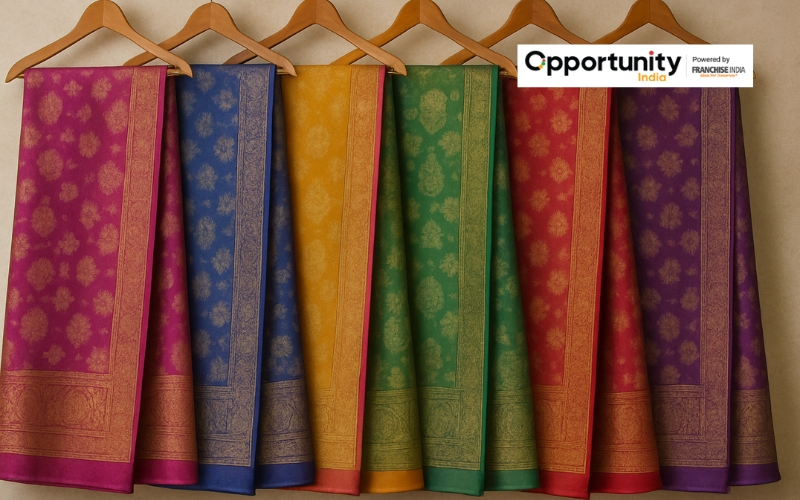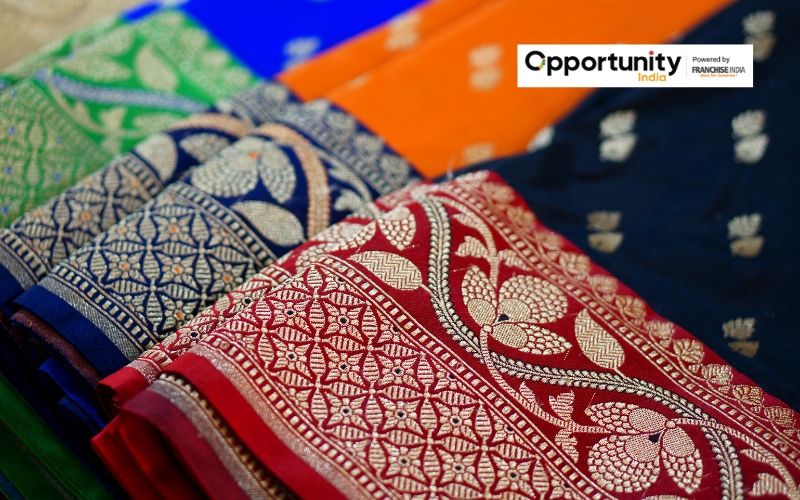
Can you imagine designing and selling beautiful sarees and making money out of it? Well, the saree business can be the most lucrative business idea to start. Sarees are more than simply garments; they are cultural. They are always in style, whether it's a teacher wearing a basic cotton saree or a bride wrapped in a bulky Banarasi. The market for sarees is flourishing. Now is the ideal moment to get to consider, as social media, online shopping, and a renewed interest in handloom and traditional fashion are all on the rise. Let's go over everything in detail so you know exactly how to start and grow your saree business.
Understanding the Saree Market in India
Sarees are more than just clothes because of India's rich textile history and deep cultural customs; they are representations of style, individuality, and artistry. Sarees are always in style, whether they are worn for a formal event, a wedding, or a joyous celebration. Starting a saree business in India can be quite profitable because of the steady, high demand for both traditional and designer sarees. However, a thorough plan, in-depth knowledge of the market, and a love of textiles and fashion are necessary for success.
Also Read: Top 10 Medical Business Ideas
The saree market in India is a thriving, multibillion-dollar sector with strong cultural and traditional ties. You're in the proper place if you've ever wanted to work in this timeless industry! The size of the Indian saree market was USD 5.76 billion in 2024 and is expected to grow at a compound annual growth rate (CAGR) of 6.70% from 2025 to 2033, reaching USD 10.33 billion.
In India, sarees are more than just clothing; they are a representation of culture, grace, and festivity. The saree business presents enormous opportunities for entrepreneurs due to the steady demand created by festivals, weddings, and everyday usage. This is further enhanced by the growth of e-commerce, which enables you to connect with clients both domestically and internationally.

Why the Saree Business in India?
Establishing a saree business in India offers more than just a business opportunity; it's an opportunity to reach the nation's emotional, cultural, and fashion-forward core. The saree industry in India is still a wise, scalable, and sustainable business for the following reasons:
An Evergreen and Timeless Market
One of the few clothing items in India that has endured over time is the saree. Sarees never go out of style, even when fashion trends change over time. For millions of Indian women of all ages, sarees are the preferred attire for formal events, festivals, religious ceremonies, and weddings. The saree industry is a solid and evergreen market because of this steady and constant demand.
Huge Cultural and Emotional Value
Sarees are a vital part of Indian culture and are more than just a piece of apparel. Tradition, elegance, heritage, and even nostalgia can all be symbolized by a saree. Sarees have great emotional significance, whether a mother is passing on her wedding gown to her daughter or a woman chooses a handwoven silk gown for her special day. Repeat business and loyal clients are the results of this emotional connection.
Also Read: Daycare Business Plan: Key Steps
A Wide Variety of Products and Niches
A vast variety of regional sarees, each with its own distinct identity—the Chanderi from Madhya Pradesh, the Patola from Gujarat, the Kanjeevaram from Tamil Nadu, and the Banarasi from Uttar Pradesh—have been created by India's varied geography. This extensive range enables business owners to select a specialty or provide a multi-style selection that appeals to various customer segments.
Growing Online Opportunities
The saree industry is no longer restricted to local markets because of e-commerce, digital marketing, and social media. Through internet markets, your own website, or social media channels, you may now sell your collection to Indian diaspora members throughout India and even abroad. Additionally, sarees have become fashionable among younger consumers due to Instagram influencers and fashion bloggers, which has increased the customer base.
Guide to Starting a Saree Business in India
What is the Market Potential
Indian sarees come in a wide variety of styles, from contemporary printed, chiffon, and designer sarees to handcrafted classic weaves like Banarasi, Kanjeevaram, and Chanderi. Understanding the various markets, consumer preferences, and regional trends is essential before you get in.
Here are some significant facts to think about:
- Festivals, weddings, and other cultural events are when demand is highest.
- While tier-2/tier-3 and rural buyers favor traditional patterns, urban buyers frequently seek out modern styles.
- The first step is to determine your niche, whether it's luxury buyers, working women, brides, or shoppers on a tight budget.
Decide Your Business Model
The saree industry can be entered in a variety of ways. You need to pick a model that works for your target market, experience, and budget.
Retail Store
For businesses looking to reach local clients, opening a real store location is the best option. It enables customers to try designs and feel the fabric. It has greater setup and running costs, though.
Also Read: Cattle Farming Business Plan: Step-by-Step Guide
Saree Business Online
Selling sarees online via your own website or on marketplaces like Amazon, Flipkart, and Myntra can save costs and expand your reach both domestically and internationally as e-commerce grows.
Wholesale Saree Industry
The wholesale strategy can be quite profitable if you wish to work with shops, boutiques, or export firms in volume.
Home-Based Enterprise
Selling sarees from home is a good way to start small. Use Facebook, Instagram, and WhatsApp to reach your audience. It's a fantastic beginning point with little commitment.
Identify Your Niche
The market for sarees is too large to serve everyone. Select a niche to make a statement:
- Traditional Handloom Sarees: Banarasi, Kanjeevaram, Patola, Chanderi, Sambalpuri
- Designer/Fashion Sarees: Perfect for weddings, cocktail parties, and other social gatherings
- Bridal Sarees: Embroidered or heavy silk wedding gowns
- Daily Wear Sarees: Cotton, synthetic, or printed varieties
- Eco-friendly or Organic Sarees: Made from sustainable materials
Choosing a specialty enables you to efficiently customize your brand messaging, marketing, and inventory.
Source Your Sarees
The uniqueness, cost, and quality of your collection are all determined by your suppliers. The following are typical source choices:
- Direct from Weavers: Establishing a network of weavers in Tamil Nadu, West Bengal, Gujarat, and Odisha will guarantee higher margins and authenticity if you trade in handloom sarees.
- Manufacturers & Wholesalers: Look to Surat, Jaipur, or Kolkata-based producers for synthetic, designer, or party wear sarees.
- Trade Shows & Exhibitions: You can meet new suppliers and stay updated with trends by going to textile expos.
- Online B2B Platforms: For large orders, websites such as TextileInfomedia, TradeIndia, and IndiaMART are helpful.
To preserve the reputation of the brand, make sure suppliers provide timely delivery, fair pricing, and quality inspections.

Set Up Your Store (Online or Offline)
It’s time to set up your store either offline or online. Here's how to set up your selling platform based on the model you've chosen:
For a Physical Store
- Pick a place with lots of foot traffic, ideally in a mall or market.
- Purchase eye-catching furnishings and display racks to elegantly present the sarees.
- To improve the client experience, provide trial spaces and helpful employees.
For an Online Store
- Make a polished website with tools like Wix or Shopify.
- Make use of excellent photos and descriptions for every saree.
- Include delivery services and payment gateways (Paytm, Razorpay, etc.).
- To reach a larger audience without a personal website, you can also post your sarees on websites like Amazon, Flipkart, or Meesho.
- Make sure your motto, logo, and packaging all exude elegance and trust.
Marketing and Branding
In a crowded market, having a strong brand identification makes you stand out. Here's how to construct it:
- Brand Name & Logo: Select a brand name and logo that conveys elegance, tradition, and confidence.
- Social Media Presence: Pinterest and Instagram are excellent sites for saree visuals.
- Influencer Partnerships: For promotions, team up with local designers and fashion influencers.
- Festive Campaigns: Flash sales are especially popular during Diwali, Navratri, and the wedding season.
- Local Advertising: If you own a retail or home-based business, use flyers, newspapers, and WhatsApp groups.
Online trustworthiness can also be increased by customer reviews and testimonials.
Also Read: How to Start a Fruit Juice Business?
Inventory Management
Keep a decent assortment of sarees according to the seasons and fashions. For instance:
- Summer: Light patterns, linen, and cotton
- Wedding season: Designer sarees and heavily embroidered silks are popular.
- Festivals: vibrant colors and traditional handlooms
To keep track of your stock and prevent overbuying or dead inventory, use tools like Excel or point-of-sale systems.
Investment Required: Saree Business
Your initial investment depends on your business model:
a) Home-Based Saree Business
- Initial Stock: ₹20,000–₹50,000
- Marketing: ₹5,000–₹10,000
- Packaging: ₹2,000–₹5,000
- Total: ₹30,000 to ₹60,000
Also Read: How to Start a Travel Food Business Service?
b) Online Saree Store
- Website Development: ₹10,000–₹25,000
- Stock: ₹50,000–₹1,00,000
- Marketing & Branding: ₹20,000–₹40,000
- Total: ₹80,000 to ₹1.5 lakh
c) Retail Store
- Rent & Interiors: ₹1.5 lakh–₹3 lakh (depending on location)
- Inventory: ₹2 lakh–₹5 lakh
- Licenses & Setup: ₹50,000–₹1 lakh
- Total: ₹4 lakh to ₹10 lakh
Conclusion
Selling fabric is only one aspect of the saree industry; another is providing heritage, beauty, and cultural pride. There are plenty of options in this sector, whether you want to start small from home or open a full-fledged boutique. You can create a profitable and long-lasting saree business in India with a well-thought-out plan, high-quality goods, and an effective marketing approach. Therefore, now is the ideal moment to literally immerse yourself in the possibility if you have a passion for ethnic fashion and an entrepreneurial spirit!

